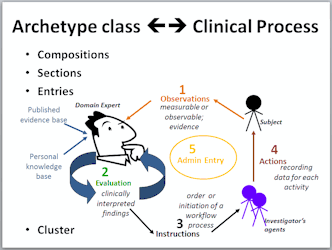
The Northern Territory approach to the creation of an electronic Pregnancy Health Record is to use clinically-agreed archetypes as the basis for an Antenatal software development.
An archetype is a structured, computable specification for one single, discrete clinical concept. Examples include Blood Pressure; Clinical Synopsis; Medication order; or Adverse Reaction.
In fact, each archetype is a rich pattern for health data, defined and agreed by the clinicians and other stakeholders. Clinician leadership and involvement is critical to ensure the quality of clinical data in our EHRs and to warrant that it is safe and 'fit for purpose'.
The agreed archetype is the basis for a coherent and consistent approach for the whole continuum of electronic clinical care and related activities:
Each archetype is designed:
There are four main types (or classes) of archetypes that are useful to understand – each corresponding to classes in the openEHR Reference Model and each has particular attributes that correspond to clinical processes. 
1. Compositions – which correspond to commonly used clinical documents, such as 'antenatal visit' or 'care plan'. (Think of these as the equivalent to the blank piece of paper in a current paper record, before you start to write.)
2. Sections – these are effectively used to assist with human navigation within EHRs and correspond to document headings, for example 'antenatal examination' or 'summary'. (Think of these as the headings that provide a framework for writing on a blank piece of paper.)
3. Entries – these are the most common and are fundamental building blocks of EHRs and will contain most of the 'stand-alone' structured clinical information. There are four main types of Entry archetypes:
4. Clusters – think of these as re-usable fragments of clinical information. They do not 'stand-alone' within a health record but provide a way to re-use a common clinical data patterns within many of the Entry archetypes. Examples include: dimension; anatomical location; change; and specimen.
Possible functions:
Background documents on NT project
Link to relevant sections of CARPA Manual